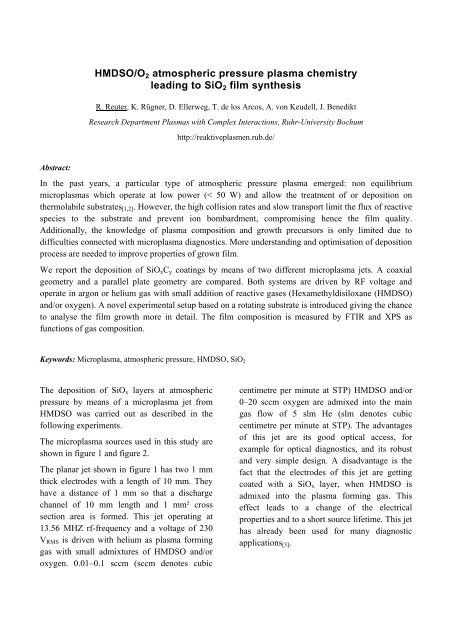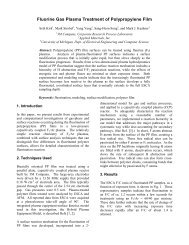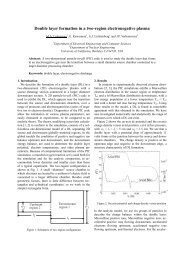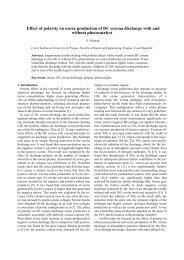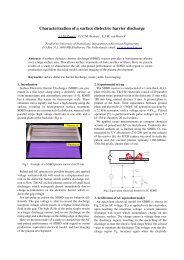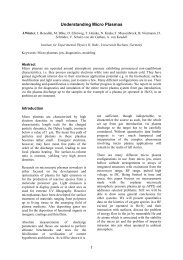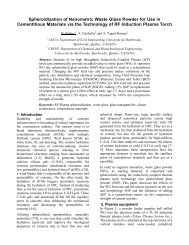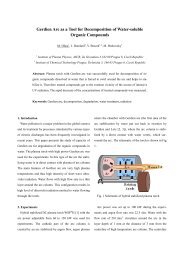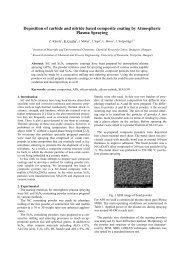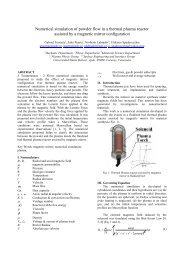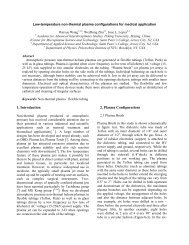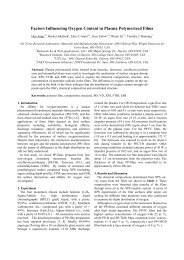HMDSO/O2 atmospheric pressure plasma chemistry leading to SiO2 ...
HMDSO/O2 atmospheric pressure plasma chemistry leading to SiO2 ...
HMDSO/O2 atmospheric pressure plasma chemistry leading to SiO2 ...
You also want an ePaper? Increase the reach of your titles
YUMPU automatically turns print PDFs into web optimized ePapers that Google loves.
<strong>HMDSO</strong>/O 2 <strong>atmospheric</strong> <strong>pressure</strong> <strong>plasma</strong> <strong>chemistry</strong><strong>leading</strong> <strong>to</strong> SiO 2 film synthesisR. Reuter, K. Rügner, D. Ellerweg, T. de los Arcos, A. von Keudell, J. BenediktResearch Department Plasmas with Complex Interactions, Ruhr-University Bochumhttp://reaktiveplasmen.rub.de/Abstract:In the past years, a particular type of <strong>atmospheric</strong> <strong>pressure</strong> <strong>plasma</strong> emerged: non equilibriummicro<strong>plasma</strong>s which operate at low power (< 50 W) and allow the treatment of or deposition onthermolabile substrates [1,2] . However, the high collision rates and slow transport limit the flux of reactivespecies <strong>to</strong> the substrate and prevent ion bombardment, compromising hence the film quality.Additionally, the knowledge of <strong>plasma</strong> composition and growth precursors is only limited due <strong>to</strong>difficulties connected with micro<strong>plasma</strong> diagnostics. More understanding and optimisation of depositionprocess are needed <strong>to</strong> improve properties of grown film.We report the deposition of SiO x C y coatings by means of two different micro<strong>plasma</strong> jets. A coaxialgeometry and a parallel plate geometry are compared. Both systems are driven by RF voltage andoperate in argon or helium gas with small addition of reactive gases (Hexamethyldisiloxane (<strong>HMDSO</strong>)and/or oxygen). A novel experimental setup based on a rotating substrate is introduced giving the chance<strong>to</strong> analyse the film growth more in detail. The film composition is measured by FTIR and XPS asfunctions of gas composition.Keywords: Micro<strong>plasma</strong>, <strong>atmospheric</strong> <strong>pressure</strong>, <strong>HMDSO</strong>, SiO 2The deposition of SiO x layers at <strong>atmospheric</strong><strong>pressure</strong> by means of a micro<strong>plasma</strong> jet from<strong>HMDSO</strong> was carried out as described in thefollowing experiments.The micro<strong>plasma</strong> sources used in this study areshown in figure 1 and figure 2.The planar jet shown in figure 1 has two 1 mmthick electrodes with a length of 10 mm. Theyhave a distance of 1 mm so that a dischargechannel of 10 mm length and 1 mm² crosssection area is formed. This jet operating at13.56 MHZ rf-frequency and a voltage of 230V RMS is driven with helium as <strong>plasma</strong> forminggas with small admixtures of <strong>HMDSO</strong> and/oroxygen. 0.01–0.1 sccm (sccm denotes cubiccentimetre per minute at STP) <strong>HMDSO</strong> and/or0–20 sccm oxygen are admixed in<strong>to</strong> the maingas flow of 5 slm He (slm denotes cubiccentimetre per minute at STP). The advantagesof this jet are its good optical access, forexample for optical diagnostics, and its robustand very simple design. A disadvantage is thefact that the electrodes of this jet are gettingcoated with a SiO x layer, when <strong>HMDSO</strong> isadmixed in<strong>to</strong> the <strong>plasma</strong> forming gas. Thiseffect leads <strong>to</strong> a change of the electricalproperties and <strong>to</strong> a short source lifetime. This jethas already been used for many diagnosticapplications [3] .
The other micro<strong>plasma</strong> source is a jet in coaxialdesign [1,4] . It is shown in figure 2. It consists of astainless steel capillary tube with inner andouter diameters of 0.2 mm and 0.5 mm insertedin<strong>to</strong> a ceramic tube with an inner diameter of 1mm <strong>leading</strong> <strong>to</strong> a gap of 250 µm between thosetwo tubes. This ceramic tube has an outerdiameter of 1.5 mm and is surrounded by analuminium strip. This strip and the stainlesssteel capillary serve as electrodes. This jet isalso driven with a rf-frequency of 13.56 MHzand a voltage of 230 V RMS . The inner flowthrough the capillary is formed by 160 sccmargon with admixtures of 0–1 sccm <strong>HMDSO</strong>.Between the capillary and the ceramic tube aflow of 3 slm of argon forms the outer flow.experimental conditions and <strong>to</strong> avoid impuritiesfor example because of oxygen or nitrogendiffusing in<strong>to</strong> the <strong>plasma</strong>.The experiments consist of two parts:In the first part the substrate has been moved infront of the jet at a distance of 4 mm with aconstant velocity of 0.5 mm/min. Moving thesubstrate is helpful for the later analysis of thefilm. To deposit the films on the substrate themicro<strong>plasma</strong> jet with the planar geometry wasused. We call this process Linear Drive Process.Main goal of this study is <strong>to</strong> understand thecorrelation between film properties and gascomposition.Ar + <strong>HMDSO</strong>Ar1mm13.56 MHzFigure 2. Coaxial Jet [1,4]Figure 1.Top: Planar JetBot<strong>to</strong>m: Linear Drive Process: Substrate is moved in front of theplanar jet with a velocity of 0.5 mm/mim. [5]All experiments were performed in a vacuumchamber that was pumped down before thedeposition process and afterwards filled withhelium or argon <strong>to</strong> ensure controlledThe second part of this study deals with arotating substrate. Here, a substrate wasmounted on a rotating disc. In this configurationtwo or even more jets could treat the surface ofthe substrate. In this way we could create a kindof alternating treatment process. Asmicro<strong>plasma</strong> sources serve the planar jet as wellas the coaxial jet. We call this process RotatingDisc Process. An exemplary view of the rotatingdisc setup is given in figure 3. The disc wasrotated with a frequency of 5 Hz. This
spectra in figure 5b show no basic differencebetween the deposition of a SiO x layer in thelinear drive process with one single <strong>HMDSO</strong>/O 2<strong>plasma</strong> and the deposition in the rotating discprocess with two separated <strong>plasma</strong>s, one withHe/<strong>HMDSO</strong> and the other one with He/O 2 . Inother experiments [5] the separation between thetwo <strong>plasma</strong>s was checked and confirmed. Thisis a clear evidence that the carbon removal is asurface reaction.deposition the coaxial jet has been used. Therotating disc process now offers the chance <strong>to</strong>check if also a surface reaction is reasonable forthe absence of carbon in the films. Firstexperiments (not shown here) have shown thatin this case a surface reaction is reasonable, <strong>to</strong>o.By replacing the planar jet driven with He/O 2<strong>plasma</strong> by the coaxial jet driven only with Ar,also carbon-free films could be deposited.We have shown that the amount of oxygen and<strong>HMDSO</strong> in the <strong>plasma</strong> plays an important rolefor the film properties and composition. Byintroducing the rotating disc process we found anew diagnostic <strong>to</strong> analyse the growthmechanisms of SiO x film deposited frommicro<strong>plasma</strong> jets. With this method we foundthe carbon loss being a surface reaction.This project is supported by DFG within theframework of the Research Group 1123 and bythe Research Department Plasmas withComplex Interactions.[1] J. Benedikt, K. Focke, A. Yanguas-Gil, andA. von Keudell, Appl. Phys. Lett. 89, 251504(2006)[2] J. Schäfer, R. Foest, A. Quade, A. Ohl, andK-D- Weltmann, J. Phys. D: Appl. Phys. 41,194010 (2008)Figure 5: FTIR spectra of film deposited in the Linear DriveProcess. Oxygen and <strong>HMDSO</strong> flows were varied. (Conditions:Linear drive: See Figure 4; Rotating disc, pure <strong>HMDSO</strong>: Jet1:0.1 sccm <strong>HMDSO</strong> Jet2: not used; Rotating disc <strong>HMDSO</strong> + O 2 :Jet1: 0.1 sccm <strong>HMDSO</strong>, Jet2: 2 sccm O 2 ). Adopted from [5].In the last years it has been shown that carbonfree films can be deposited from <strong>HMDSO</strong> evenwithout addition of oxygen [4] . For this[3] N. Knake, K. Niemi, S. Reuter, V. Schulzvonder Gathen, and Jörg Winter, Appl. Phys.Lett., 93 131503 (2008)[4] V. Raballand, J. Benedikt, S. Hofmann, M.Zimmermann, and A. von Keudell, J. Appl.Phys. 105, 083304 (2009)[5] R. Reuter, D. Ellerweg, A. von Keudell, andJ. Benedikt, Appl. Phys. Lett.98, 111502 (2011)


